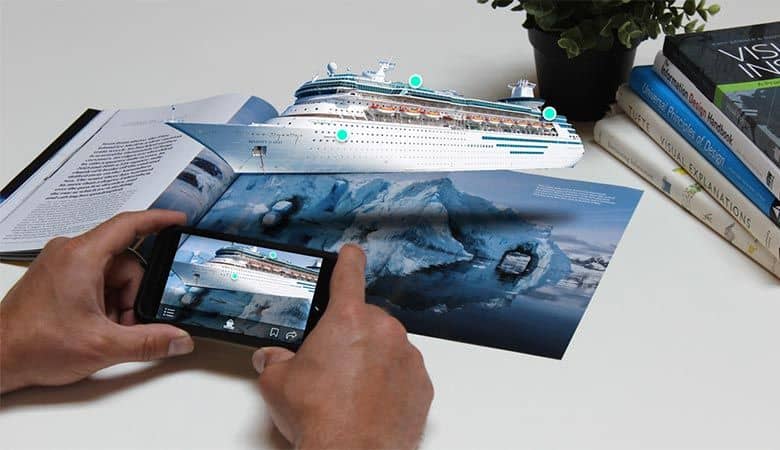Food & Drink
How Emerging Technologies Will Change How You Shop
With the next generation of Apple devices, virtual and augmented reality is about to explode in popularity
By Teresa Kenney August 29, 2017

This post is sponsored.
sponsored by Seattle Interactive
Looking down on New York City from the edge of a helicopter skid. Interacting with the creatures of the rainforest. Listening to the clicks and whistles of dolphins and whales as they circle above and below.
You don’t need to be a globe-trotting adventurer to enjoy all of these experiences. In fact, you don’t even need to leave the comfort of your own couch. You just need to step into the art-imitating-life worlds of virtual and augmented realities.
Virtual (VR) and augmented (AR) realities are “similar but different,” explains Adam Sheppard, CEO and cofounder of 8ninths, a Seattle-based mixed and virtual reality creative studio. “Virtual reality is when you put on a headset and you’re completely isolated from the external world; you’re not able to see what’s in front of your face, and you’re kind of transported to a different place. It could be a 360 video or an interactive video game, but you can’t see the physical world when you’re in a virtual reality headset.
“Augmented reality is a slightly different experience, in that you can actually see the physical world; you are looking through a pair of transparent glasses, such as Microsoft HoloLens or Meta. We’re able to project 3D objects onto those lenses that make it appear as though there’s an object in the world that actually isn’t there.”
8ninths—which is named for the portion of an iceberg that is hidden beneath the water’s surface—was chosen by the Microsoft HoloLens team for its Holographic Academy and has partnered with companies such as Oculus, Samsung and Facebook, on their digital creative projects. The company—which has a portfolio of its work on its Youtube channel—has been a pioneer in new digital technology.
“Seattle companies are really positioned to be at the center of what is happening with AR/VR in marketing,” says Seattle Interactive Conference founder Brian Rauschenbach. “We’ve got such a hive of leading tech, retail, and creative agencies working so close together.”
“It’s pretty exciting to see companies like 8ninths and Microsoft inspire retail giants like REI and Amazon, and then watch the creative minds from our local agencies spin it all into really innovative campaigns. That’s the essence of what happens at Seattle Interactive Conference. When you get all those different innovative thinkers in a room together, new connections are made, and great ideas are born.”
Game-changing Release
While virtual reality goggles are fairly inexpensive (Google Cardboards can be purchased for under $10), augmented reality headsets, such as HoloLens and Meta, cost “in the multiple thousands of dollars range and have mainly been focused on business and enterprise,” says Sheppard.
That’s all about to change with Apple’s official release of its iOS 11 upgrade this fall. The upgrade will equip all iPhone models 6S upwards, all iPad Pros, and the 2017 9.7-inch iPad with AR capabilities through its ARKit technology.
“Overnight, the predictions are that there are 400 million-plus devices that will have this capability when iOS 11 is updated. So you’re talking about Apple all of a sudden becoming the number one provider of augmented reality technology in the world, which is a pretty significant change in how we interact with our devices and computers in general,” says Sheppard.
Running an application, iPhone or iPad users will be able to use their camera functionality to project a 3D object into an existing space. “So you might be thinking of buying a new car. Rather than going to a website and flipping through a bunch of pictures there, you could have the vehicle in super-high resolution displayed in your driveway. You can look at different colors and options and trims and really walk around it by looking in your phone as if the actual vehicle was there,” explains Sheppard.

Furnishing your home could also become more interactive. “Another example could be you’re picking out a new piece of furniture, maybe a dining room table or couch…the camera would look at the room that you’re holding the camera up to and then give you options to try different pieces of furniture. It could be a couch, a table, a chair, a lighting fixture. But it will look as though it is actually in your environment,” he says.
Sheppard’s company is introducing its own application that will allow users to experience augmented reality for free. By downloading 8ninth’s app, users will receive a daily virtual gift box with a link to “unwrap” it.
“In your living room you would just kind of place it on the floor; the box will animate and shake a little bit. And then it will open up to provide an interesting content experience on a daily basis. You never know what that’s going to be. It could be a remote-controlled virtual drone that you can fly around your house or yard. It might be a little pet puppy or fox that will obey your commands or do little animations just as a cute way to spend a few minutes. It could be an effect where there are whales surrounding you and giving you the sensation that you’re underwater,” explains Sheppard.
From a marketing perspective, Apple’s upgrade will provide brands with a new tool to reach consumers en masse. But while most brands want to be thought of as first-adopters when it comes to technology, should they all make the leap into the virtual and augmented advertising worlds?
Not without a lot of planning and strong partnerships, says Patrick Chaupham, executive vice president of creative technology at Weber Shandwick.
Gimmicky or Good Business?
Chaupham, along with Weber Shandwick’s Mediaco Creative team, developed the first Oculus Rift Virtual Reality Immersive Film for a large consumer brand—Ocean Spray—and has more than 17 years of experience in digital technology.
“A lot of engagements seem to be ‘stunty’ or one-time, so an organization needs to ask itself if it’s ready for a virtual program in general. They are highly complex story-telling platforms,” says Chaupham. He suggests companies make sure that their social channels and editorial programming on Facebook or Youtube channels are prepared for that type of programming, rather than “randomly posting a piece that might be jarring and won’t have an audience.”
Chaupham says companies should consider the following before employing VR or AR in their advertising.
- Does your brand have solid channel planning across your social platforms to support VR/AR content?
- Are partners included for technical, production and creative expertise?
- Does your brand’s story translate to AR or VR? Are there data or infographic elements that could add to the narrative, or a creative immersive narrative that lends itself to the brand? Using VR to promote your brand may result in a quick “blip” in engagement, but if your brand doesn’t already have a good solid drum beat of content, then it’s quite possible you won’t get a lot of traction with immersive content.
- In addition to the story, think deeply about the user experience: What they will see? How might they feel and navigate the experience? You don’t have control over where a user is focused or looking, so be conscious of that as part of the narrative.
“Remember how we as humans act and behave, we don’t walk around spinning our heads at all times, we establish our surroundings and then focus on what we want to engage in, so whatever the story is we are trying to tell, make sure we are using all the tools at our disposal—for example light, color, as well as audio cues for a truly immersive, engaging experience,” adds Chaupham.
Both Sheppard and Chaupham will be presenting (in person, no VR or AR glasses required) at the Seattle Interactive Conference. The conference is taking place at The Conference Center at the Washington State Convention Center on October 17–18, 2017. For more information, visit seattleinteractive.com.




